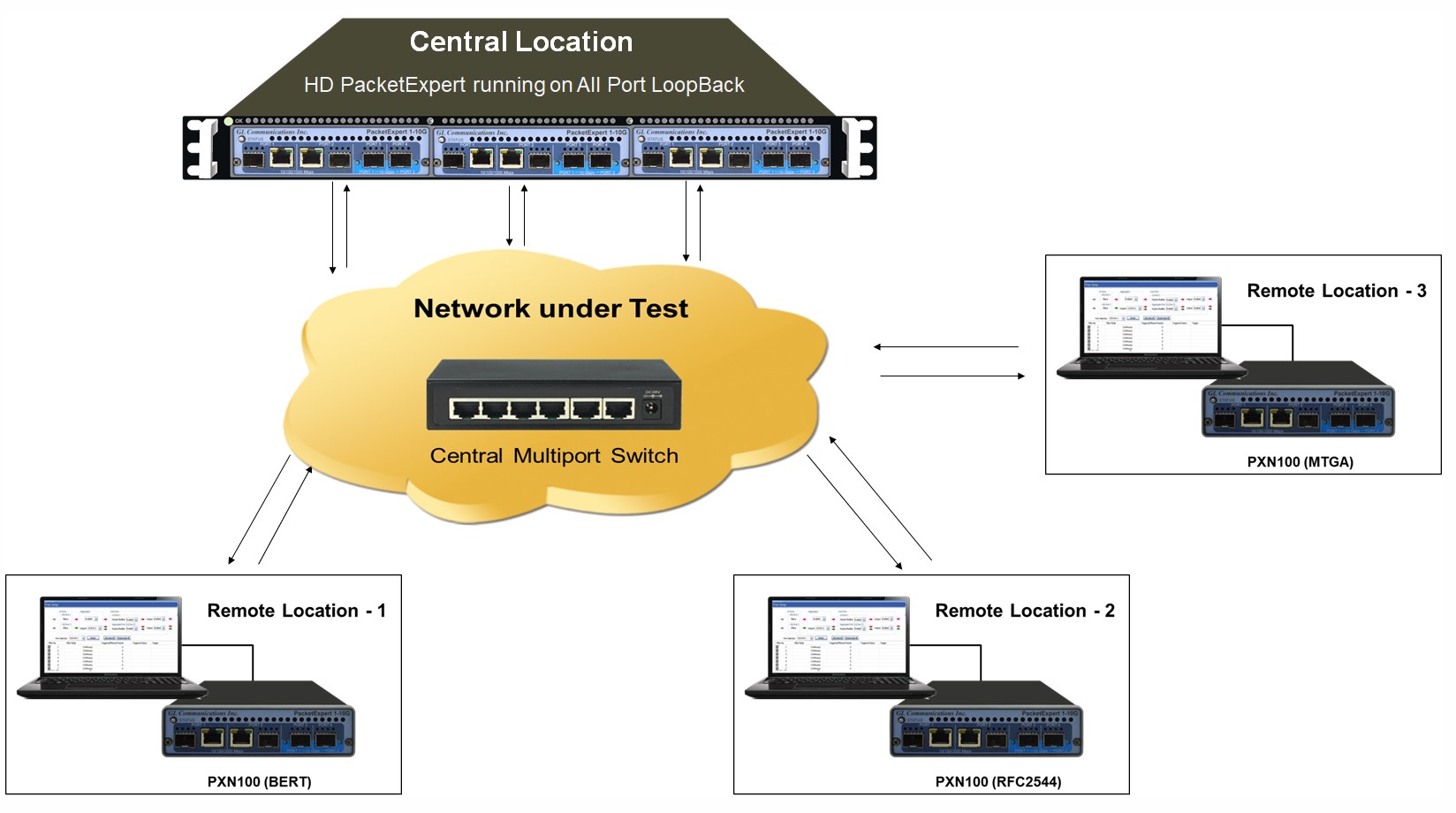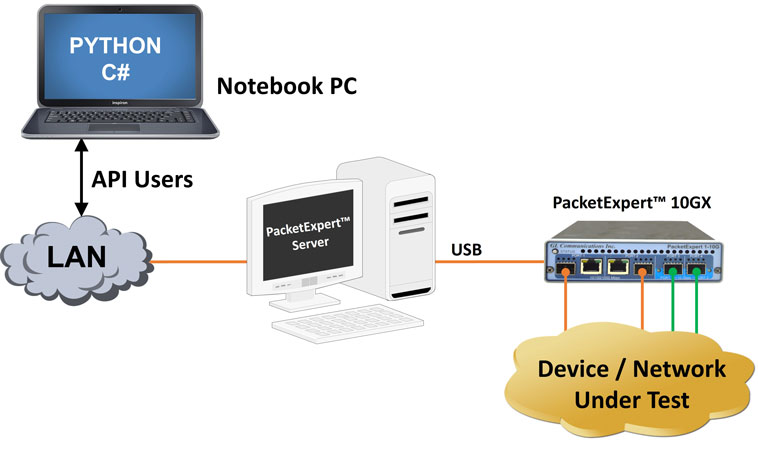High Density Multiport 1G/10G Ethernet Switch Testing Made Easy!!
Welcome to December, 2018 issue of GL Communications' Newsletter providing information and insights on Testing High Density Multiport 1 Gigabit/ 10 Gigabit Ethernet Switches for Functionality, Throughput and related parameters using GL’s Integrated multi interface Rackmount (mTOP™) Test Platform and HD PacketExpert™ 10GX a versatile Ethernet based Testing Tool.

Introduction
With the explosion of interconnected devices and the coming internet of things, the demand for higher density switching devices has been increasing. Vendors are coming out with switches with ever increasing number of Gigabit Ethernet ports. Ethernet switches with 12 or 24 Gigabit ports are getting common. Another trend is the demand for higher data capacity pipes. 10 Gigabit Ethernet links are getting common, as more users switch to 10G from 1G. High density Gigabit Ethernet switches now typically have 2 or 4 10G ports. Also, high density “All 10G” switches with 4/8/16/24 10G ports are also being deployed as end users switch to “All 10G” environment in their premises.
Testing of such high density 1G/10G switches requires a corresponding high-density test equipment, with a high density of ports. To properly test such high-density switches, the test equipment must be capable of generating and handling traffic at full 1 Gigabits/sec or 10 Gigabits/sec on all its 1G/10G ports, simultaneously. That means, to test a 12 or 24 port Gigabit ethernet switch, the test equipment must be capable of generating Gigabits/sec rate on all 12/24 ports, and simultaneously capable of handling the traffic returned from the switch, and analyze for errors, totalling to a capacity of 24 Gbps or 48 Gbps. Similarly, to test a switch with 3/6 10G ports, requires a traffic capacity of 60/120 Gbps in total.
GL's High-Density versatile test equipment referred to as Integrated multi interface Rackmount (mTOP™) Test Platform and HD PacketExpert™ 10GX facilitates the testing of Multiport Ethernet Switches with ease and accuracy. The Important test procedures are Wire speed BERT, RFC 2544 Testing, Smart Loopback, ExpertSAM, Record and Playback, PacketBroker, WAN Link Emulation, Multi Stream Traffic Generator and Analyzer, and ExpertTCP.
Following are the High-Density variants in 1U and 2U mTOP™ rack units –
The high-density testers are enclosed within GL's mTOP™ 1U/2U rack mount enclosures. It is compact with reduced power requirements appliance for high performance. It is a perfect ethernet test tool for customers who require multi-port testing but are constrained by lab space. An optional 12-port TTL interface, consisting of 12 users configurable TTL triggers, is also supported for both the units.
Multiport Ethernet Switch Testing Procedures
GL’s HD PacketExpert™ 10GX helps Testing Multiport Switches in 3 Stages:
Basic Bit Error Rate Testing (BERT) - In this, Layer2/Layer3/Layer4 frames containing BERT payload of various frame sizes are sent at full line rate to each port of the switch. The forwarded traffic from the switch is received by HD PacketExpert™ 10GX and analyzed for Bit Errors, Pattern Sync etc. BERT testing represents a basic first level testing, making sure that the switch can handle full line rate on all the ports without dropping or corrupting even a single bit. PacketExpert™ 10GX supports BERT on all 12 or 24 1G ports and on all 6 or 12 10G ports.
RFC 2544 Testing - Once the BERT process of the switches accomplished, next stage involves the testing of Throughput, Latency (Delay), Packet Loss (at different rates), and also ability to handle bursty traffic etc. RFC 2544 testing helps in testing and measuring the aforementioned test parameters. HD PacketExpert™ 10GX supports RFC 2544 testing on 3 or 6 1G “Port Pairs” simultaneously (1G or 10G) i.e. RFC 2544 tests are conducted using Port Pairs.
Multi stream Testing - The ability of the switch to handle multi stream traffic simultaneously is an important feature to be tested. When packets with multiple MAC addresses, VLAN tags, and IP addresses hit the same port, the switch has to process these packets and forward them correctly without introducing any impairment. HD PacketExpert™ 10GX supports multi stream traffic generation on 3 or 6 ports simultaneously (up to 16 streams per port), at full line rate. Each port can generate a mix of Layer2/Layer3 streams with different MAC/IP addresses and VLAN tags. Using a remote loopback, the traffic is routed back to HD PacketExpert™ 10GX and analyzed for Throughput, Delay, Packet Loss and Packet jitter per stream.
HD PacketExpert™ 10GX also supports Y.1564 based Ethernet Service Activation testing and multi stream TCP testing.
Test Automation - HD PacketExpert™ 10GX provides APIs in .NET (C#) and scripting languages like Python and TCL. The APIs are provided as a client-server model, where the server is the HD PacketExpert™ 10GX device, and the client can be running on a different system, connecting to the device through TCP/IP. APIs provide several advantages like:
- Allows users to automate tests, develop complex testing scenarios (eg: first run BERT test, then RFC 2544 and then MultiStream test) and run for long durations unattended
- Increase the density of test ports by connecting to and controlling multiple HD PacketExpert™ 10GX devices from a single client.
Eg: Connect to two HD PacketExpert™ 10GX devices from a single client and run tests between them, with the DUT in between - Integrate into Test Automation tools like LabVIEW, so that HD PacketExpert™ 10GX can be easily incorporated into overall test plan
Simultaneous Testing of Multiport Switches
BERT and RFC 2544 Testing
Wirespeed BERT measures Bit Error Rate on Layer1, Framed Ethernet (Layer2), MPLS (Layer2.5), IP and UDP layers. Supports generating various PRBS patterns such as 29-1, 211-1, 215-1, 220-1, 223-1, 229-1, and 231-1 including constant patterns such as All Ones, All Zeroes, Alternate Ones-Zeroes and user-defined test patterns ranging from 1 bit to 32 bits. Selection of optional sequence number insertion allows detecting out-of-sequence packets and packet loss.
HD PacketExpert™ 10GX supports Throughput, Latency, Frame Loss and Back to Back tests as specified in RFC 2544. Similar to BERT, RFC 2544 can be performed over Framed Ethernet (Layer2), Stacked VLAN (Q-in-Q), Stacked MPLS, IP or UDP.
RFC 2544 allows the test frame to be configured with Stacked VLAN and Stacked MPLS. This way, end to end RFC 2544 test can be conducted across a Carrier Ethernet/MPLS network.
Testing with “Port Pair” Configuration
All 24 ports of a switch can be simultaneously tested by configuring HD PacketExpert™ 10GX to test Port Pairs as shown in the figure below:

Testing from remote locations with a centralised high-density Traffic Loopback responder
HD PacketExpert™ 10GX also supports Smart Loopback capability on all the 12/24 1G or 6/12 10G ports simultaneously. Each of the port can be configured to loopback incoming traffic, after swapping the MAC/IP addresses. The device is capable of looping back full line rate traffic on all 12/24 1G or 6/12 10G ports simultaneously. This Loopback capability can be used in testing a big network, spread over a wide area (typically service provider network), by installing HD-PacketExpert in the centralised location, so that it receives BERT/RFC 2544/Multi stream IP traffic from portable testers located at various remote locations in the network, and loops them back. The portable field testers can then easily test various parameters like the Bit Error Rate, Throughput, Frame Loss, Latency (Round Trip), Jitter etc.

| Frame Sizes |
|
Jumbo Frame Size Support |
Supports up to 16000 frame size to test handling of jumbo frames |
| Varying Frame Size | Generates traffic with variable frame size between a user configured minimum, maximum and the step size (for BERT only) |
| Rate |
|
| Layer-wise Testing | Supports stress testing the DUT over the following layers:
|
| Bert Measurements |
|
| RFC 2544 |
|
| MTGA |
|
| Loopback |
|
Other Features
- User-friendly GUI to get started quickly
- Python, TCL, C# APIs for automation. Eg: for integration with Lab view
- Command line Interface (CLI) to access all the functionalities remotely such as using TCL, Python, C# APIs and MAPS™ CLI Client/Server architecture
- Real-time results presented per Port and all-Port basis in both tabular as well as graphical formats
- Detailed test result reports for each of the simultaneous tests in PDF and CSV file formats





 Back to Newsletter Index Page
Back to Newsletter Index Page